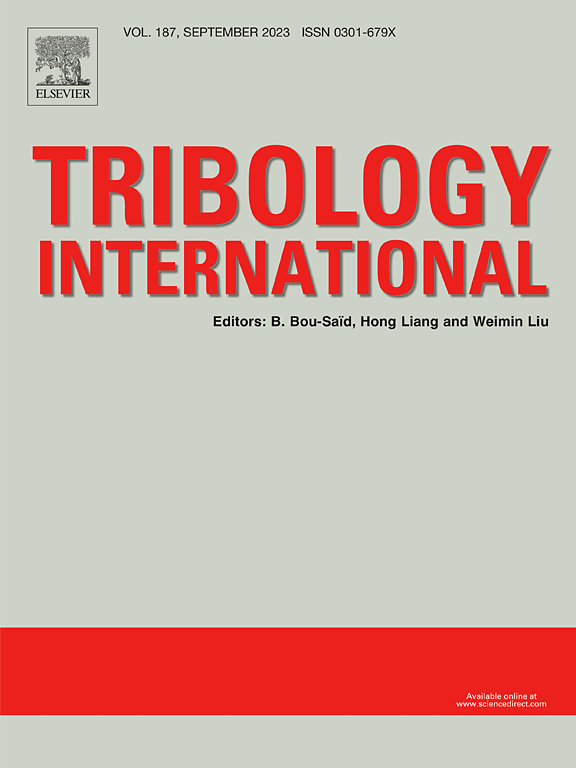Ti-6Al-4V粘接层的形成及其对摩擦学性能和表面完整性的双重作用:对加工工艺的影响
IF 6.1
1区 工程技术
Q1 ENGINEERING, MECHANICAL
引用次数: 0
摘要
Ti-6Al-4V (Ti64)具有粘附磨损和磨料磨损、低导热性和高化学反应性等特点,其较差的可加工性继续阻碍着高效制造。在这些挑战中,尽管对刀具降解和工件表面完整性有重要影响,但对刀具侧面的粘接层形成仍知之甚少。为了解决这个问题,本研究通过实验和数值方法研究了WC/Co-Ti64销盘滑动接触在干润滑和最少量润滑(MQL)条件下的摩擦学行为。实验结果表明,在干燥和低MQL流量条件下,WC/Co销表面可形成厚实、稳定、完整的Ti64盘转移胶层。这些层与降低摩擦系数和降低阀瓣磨损有关,但同时也会损害表面完整性。对比边界元法(BEM)对316 L不锈钢的模拟结果表明,较低的弹性模量显著降低了Ti64粘接层的名义接触压力和地下von Mises应力,降低了摩擦系数,提高了粘接层的机械稳定性。然而,随着表面粗糙度的增加,局部应力集中加剧,导致Ti64盘上的加工硬化层变厚,这与BEM模拟结果吻合得很好。相反,高MQL流量抑制粘接层的形成,导致更高的摩擦和磨损,但产生更光滑的表面和更薄的加工硬化层。这些发现为胶粘剂层、润滑和表面形貌之间复杂的相互作用提供了新的机理见解,并首次直接证明了胶粘剂层的双重作用:减少摩擦和工具侧磨损,但损害工件表面完整性。本文章由计算机程序翻译,如有差异,请以英文原文为准。
Adhesive layer formation and its dual role in tribological performance and surface integrity of Ti-6Al-4V: Implications for the machining process
The poor machinability of Ti-6Al-4V (Ti64), characterized by adhesive and abrasive wear, low thermal conductivity, and high chemical reactivity, continues to hinder efficient manufacturing. Among these challenges, adhesive layer formation on tool flank faces remains poorly understood despite its critical influence on tool degradation and workpiece surface integrity. To address this, this study investigates the tribological behavior of WC/Co-Ti64 pin-on-disc sliding contacts under dry and minimum quantity lubrication (MQL) conditions through both experimental and numerical approaches. Experimental results show that thick, stable, and intact adhesive layers transferred from Ti64 discs was formed on WC/Co pin surfaces under dry and low MQL flowrate conditions. These layers are associated with reduced friction coefficients and lower disc wear but simultaneously contribute to compromised surface integrity. Comparative boundary element method (BEM) simulations with 316 L stainless steel reveal that the lower elastic modulus of Ti64 adhesive layers significantly reduces nominal contact pressure and subsurface von Mises stress, lowering friction coefficients and enhancing mechanical stability of adhesive layer. However, the accompanying increase in surface roughness intensifies local stress concentrations and result in thicker work-hardened layers on Ti64 disc, which align well with BEM simulation results. Conversely, high MQL flowrate inhibited adhesive layer formation, leading to higher friction and wear but producing smoother surfaces and thinner work-hardened layer. The findings offer new mechanistic insights into complex interplay between adhesive layer, lubrication and surface topography, and present the first direct evidence of the dual role of adhesive layer: reducing friction and tool-side wear but compromising workpiece surface integrity.
求助全文
通过发布文献求助,成功后即可免费获取论文全文。
去求助
来源期刊

Tribology International
工程技术-工程:机械
CiteScore
10.10
自引率
16.10%
发文量
627
审稿时长
35 days
期刊介绍:
Tribology is the science of rubbing surfaces and contributes to every facet of our everyday life, from live cell friction to engine lubrication and seismology. As such tribology is truly multidisciplinary and this extraordinary breadth of scientific interest is reflected in the scope of Tribology International.
Tribology International seeks to publish original research papers of the highest scientific quality to provide an archival resource for scientists from all backgrounds. Written contributions are invited reporting experimental and modelling studies both in established areas of tribology and emerging fields. Scientific topics include the physics or chemistry of tribo-surfaces, bio-tribology, surface engineering and materials, contact mechanics, nano-tribology, lubricants and hydrodynamic lubrication.
 求助内容:
求助内容: 应助结果提醒方式:
应助结果提醒方式:


